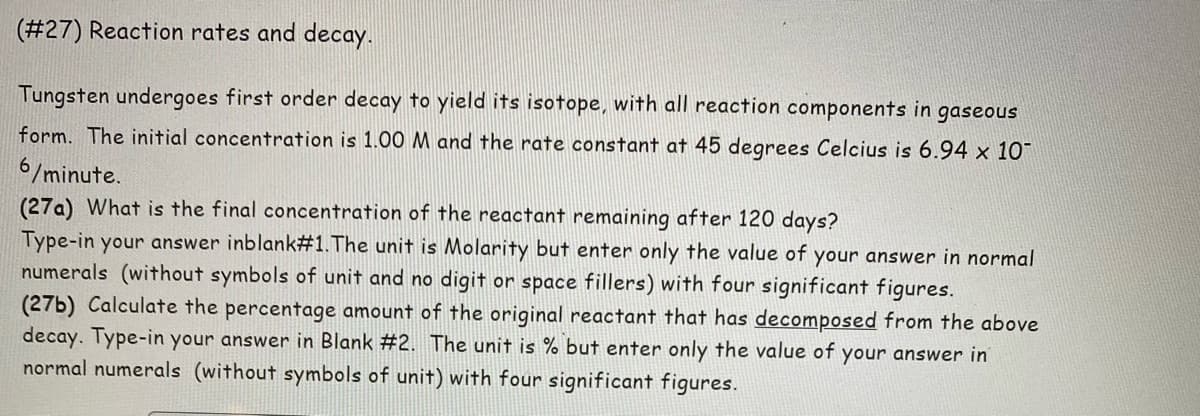Tungsten undergoes first order decay to yield its isotope, with all reaction components in gaseous form. The initial concentration is 1.00 M and the rate constant at 45 degrees Celcius is 6.94 x 10- 6/minute. (27a) What is the final concentration of the reactant remaining after 120 days? Type-in your answer inblank#1. The unit is Molarity but enter only the value of your answer in normal numerals (without symbols of unit and no digit or space fillers) with four significant figures. (27b) Calculate the percentage amount of the original reactant that has decomposed from the above decay. Type-in your answer in Blank #2. The unit is % but enter only the value of your answer in normal numerals (without symbols of unit) with four significant figures.
Tungsten undergoes first order decay to yield its isotope, with all reaction components in gaseous form. The initial concentration is 1.00 M and the rate constant at 45 degrees Celcius is 6.94 x 10- 6/minute. (27a) What is the final concentration of the reactant remaining after 120 days? Type-in your answer inblank#1. The unit is Molarity but enter only the value of your answer in normal numerals (without symbols of unit and no digit or space fillers) with four significant figures. (27b) Calculate the percentage amount of the original reactant that has decomposed from the above decay. Type-in your answer in Blank #2. The unit is % but enter only the value of your answer in normal numerals (without symbols of unit) with four significant figures.
Chemistry for Engineering Students
4th Edition
ISBN:9781337398909
Author:Lawrence S. Brown, Tom Holme
Publisher:Lawrence S. Brown, Tom Holme
Chapter11: Chemical Kinetics
Section: Chapter Questions
Problem 11.91PAE
Related questions
Question

Transcribed Image Text:(#27) Reaction rates and decay.
Tungsten undergoes first order decay to yield its isotope, with all reaction components in gaseous
form. The initial concentration is 1.00 M and the rate constant at 45 degrees Celcius is 6.94 x 10
6/minute.
(27a) What is the final concentration of the reactant remaining after 120 days?
Type-in your answer inblank#1. The unit is Molarity but enter only the value of your answer in normal
numerals (without symbols of unit and no digit or space fillers) with four significant figures.
(276) Calculate the percentage amount of the original reactant that has decomposed from the above
decay. Type-in your answer in Blank #2. The unit is % but enter only the value of your answer in
normal numerals (without symbols of unit) with four significant figures.
Expert Solution
This question has been solved!
Explore an expertly crafted, step-by-step solution for a thorough understanding of key concepts.
Step by step
Solved in 3 steps with 3 images

Knowledge Booster
Learn more about
Need a deep-dive on the concept behind this application? Look no further. Learn more about this topic, chemistry and related others by exploring similar questions and additional content below.Recommended textbooks for you

Chemistry for Engineering Students
Chemistry
ISBN:
9781337398909
Author:
Lawrence S. Brown, Tom Holme
Publisher:
Cengage Learning

Chemistry by OpenStax (2015-05-04)
Chemistry
ISBN:
9781938168390
Author:
Klaus Theopold, Richard H Langley, Paul Flowers, William R. Robinson, Mark Blaser
Publisher:
OpenStax

Chemistry: An Atoms First Approach
Chemistry
ISBN:
9781305079243
Author:
Steven S. Zumdahl, Susan A. Zumdahl
Publisher:
Cengage Learning

Chemistry for Engineering Students
Chemistry
ISBN:
9781337398909
Author:
Lawrence S. Brown, Tom Holme
Publisher:
Cengage Learning

Chemistry by OpenStax (2015-05-04)
Chemistry
ISBN:
9781938168390
Author:
Klaus Theopold, Richard H Langley, Paul Flowers, William R. Robinson, Mark Blaser
Publisher:
OpenStax

Chemistry: An Atoms First Approach
Chemistry
ISBN:
9781305079243
Author:
Steven S. Zumdahl, Susan A. Zumdahl
Publisher:
Cengage Learning


Chemistry
Chemistry
ISBN:
9781305957404
Author:
Steven S. Zumdahl, Susan A. Zumdahl, Donald J. DeCoste
Publisher:
Cengage Learning

Chemistry: Matter and Change
Chemistry
ISBN:
9780078746376
Author:
Dinah Zike, Laurel Dingrando, Nicholas Hainen, Cheryl Wistrom
Publisher:
Glencoe/McGraw-Hill School Pub Co